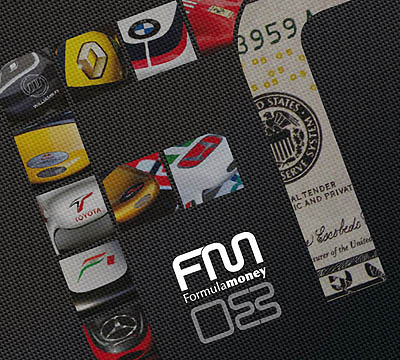


02/09/2008
NEWS STORY
 |
The 2008-09 edition of Formula Money, the annual review of F1's finances, launched late last week, shows that F1 could be in for a crash if its current level of spending continues whilst the economy gets gloomier.
For years F1's power brokers have been saying that the sport's costs would be cut. Indeed this year Prodrive was expected to enter F1 on a budget of just £50m. However, things didn't quite turn out that way as its entry hit more than a few roadblocks. It is now coming to light just how short its £50m budget would have fallen.
Formula Money is written by Pitpass' business reporters Christian Sylt and Caroline Reid and published in partnership with CNC, the consultancy which has represented all of the car manufacturers participating in F1. The book analyses the most recent accounts of all UK F1 teams and reveals that their combined costs rose by £22.3m to £573.7m in 2006. This is made all the more incredible by the fact that Force India's costs could not be included in the 2006 total since the team's accounts have still not been filed. Its 2005 costs came to £47.9m and, if anything, are likely to have increased. At the other end of the spending spectrum there have also been a few changes.
Honda has now become the biggest employer of any of the UK teams with 558 staff compared to 547 at McLaren, the second-biggest. Formula Money estimates that the Japanese car manufacturer is now spending more on its F1 campaign than any other team owner with its £195m contribution reflecting an increased investment in the KERS energy recovery system and a boosted budget for new boss Ross Brawn.
According to Formula Money, Honda has now invested so much in F1 that its spending on the sport exceeds that of any other car manufacturer at a total of £800m over the past five years. It is closely followed by Toyota at £775m and McLaren at £665m. Having 'only' spent an estimated £185m on its F1 programme over the past five years, Ferrari lies in last place in terms of manufacturer investment. However, as Formula Money also reveals, the picture is completely reversed when looking at the bang the Italian outfit gets for its buck.
The holy grail for F1 sponsors is measuring return on investment since they don't put in millions for nothing. There are many companies which analyse how much air-time sponsors' logos get on F1 television broadcasts but this is only half of the story. The other piece of the puzzle is looking at exposure in print media but no company has compiled this data for the sport… until now.
Formula Money has searched the archives of over 14,000 newspapers and magazines across the globe to work out how many times in 2007 each sponsor was mentioned in articles which also mention F1. The results show that Renault's title partner ING got more print media coverage than any other F1 sponsor with 883 articles mentioning its name and F1. With 681 articles Vodafone was second followed by Fiat and Shell. And although Ferrari didn't dominate this list, there were more articles mentioning its name and F1 than any other team owner.
In fact, the 13,643 articles mentioning Ferrari and F1 in 2007 was nearly double the total for the second placed Renault. Money clearly counts when it comes to coverage but value for money is another matter. With access to estimates for every sponsorship deal in F1, Formula Money has been able to calculate the sponsors' return on investment by comparing their spending against their print media exposure.
Perhaps surprisingly, Williams is the team with the most articles mentioning its sponsors and F1 per million dollars they invest. On average, its sponsors get 418 articles per million dollars compared to 356 for second-placed Ferrari. Languishing at the bottom of the list are Red Bull and Toro Rosso with its sponsors respectively getting 15 and 5 articles per million dollars invested.
Likewise, Williams tops the return on investment list for individual sponsors. Although heavyweights like ING and Vodafone get the most press coverage, they pay top dollar for it. In contrast, there were 225 articles mentioning the name of Williams' sponsor Allianz and F1 last year and at an estimated investment of just £550,000 it got the best return on investment. Similarly, McLaren sponsor Hilton pays only around £1.7m but gets over 300 articles which puts it third on the list. Prospective sponsors should perhaps take note that none of the top ten sponsors getting the best value for money were paying over £2.8m.
But the analysis is also of some relevance to the man down the pub as it proves the point that the media tends to favour its home heroes.
Formula Money has worked out the print media exposure in all languages core to F1 and the results show that sponsors get their best returns in their home markets. For example, half of the top ten most exposed sponsors in the Italian media were from Ferrari with Fiat at the top. Similarly, Munich-headquartered Allianz was the most-exposed sponsor in Germany with BMW's partner Credit Suisse, the third. And in the Spanish media, McLaren, home of course to Fernando Alonso last year, got more articles mentioning its sponsors names' and F1 than any other team.
Seeing where their money is being best spent could be exactly what the sponsors' need since with the economy getting gloomier they are sure to be watching the pennies even closer.